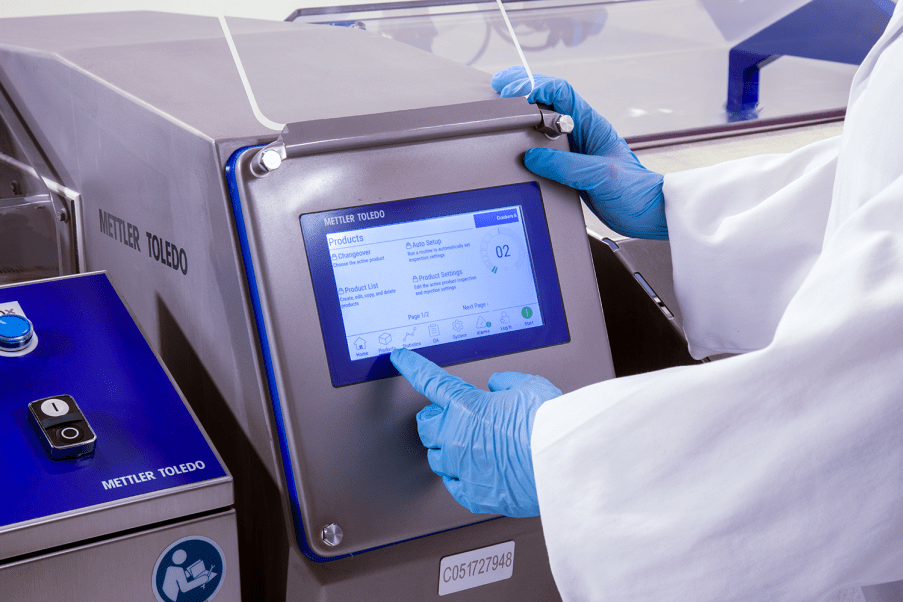METTLER TOLEDO is offering precision instruments and services for many applications in R&D, quality control, production, logistics and retail to customers around the world.
Siddharth Kachroo, Head of Sales Product Inspection, Mettler-Toledo India Pvt Ltd. Mr. Kachroo an email interaction with www.foodprocessingbazaar.com (Future Today Media Group) reveals the current scenario in the Indian market and outlook for his company Excerpts.
Q1. What is the importance of metal detectors in food processing industry?
Metal detectors play a crucial role in the food processing industry by protecting the safety and integrity of food products. Here are key points that highlight their importance:
- Preventing Contamination: Metal detectors help identify and remove metal contaminants, such as fragments from machinery, packaging materials, or utensils, that can accidentally enter food products during processing. This helps prevent potential injuries to consumers and upholds the quality of the food.
- Compliance with Food Safety Standards: Using metal detectors is often a part of a Hazard Analysis and Critical Control Points (HACCP) programme and GFSI food safety standards (e.g., BRCGS, IFS and others). This signifies that food processing facilities comply with regulatory requirements and industry guidelines.
- Protecting Brand Reputation: Detecting and removing metal contaminants before products reach consumers helps avoid costly product recalls and protects brand reputations. This is especially important in today’s competitive market where consumer trust is paramount.
- Enhancing Operational Efficiency: Modern metal detection technology allows for quick and easy fine-tuning of detection settings, helping to reduce false rejects and minimise production line downtime. This also helps to maintain high productivity levels while protecting food safety.
- Handling Different Types of Contaminants: Metal detectors can identify various types of metallic contaminants, including ferrous, non-ferrous, and stainless steel, even in challenging conditions such as products with high salt or moisture content or environmental vibration interference.
Q2. What is the current status of usage of metal detectors in Indian food industry?
In India, the use of metal detectors in the food industry is increasing. This growth is driven by a need for regulatory compliance, consumer protection, and improved food safety. Many food processing facilities are adopting advanced metal detection technology to automatically detect and rejectmetal contaminants, thereby protecting the safety and quality of food products. This is supported by regulatory frameworks like Food Safety and Standards Authority of India (FSSAI) and various food safety standards. In short, metal detectors are becoming more common practice within manufacturing facilities as they help meet safety regulations and protect consumers from substandard products.

Q3. Brief us about the new types of food safety and control measures being adopted in the food industry(metal detectors, X rays and screenings)
Globally, as well as in India, food safety measures are evolving to address various challenges. The implementation of Hazard Analysis and Critical Control Points (HACCP) analysis helps identify and manage potential hazards in food production. Good Manufacturing Practices (GMP) and Good Hygienic Practices (GHP) confirm consistent quality and hygiene in food processing environments. Preventive controls, such as sanitation and environmental monitoring, are being adopted to prevent food safety hazards. Businesses are increasingly using food safety management software to track compliance and maintain records. Traceability systems are being implemented to track food products from farm to fork, providing companies with the information needed to respond quickly to any issues.
Advanced contamination detection technologies, such as metal detectors and x-ray systems, are used to detect foreign bodies in food products. Metal detectors help identify and remove harmful metallic contaminants whilst x-ray inspection systems further enhance safety by detecting other foreign objects, such as glass, stones, calcified boneand dense plastics.
With the rise of automation, systems are also able to handle automated product setup and changeovers, reducing downtime and minimising human errors, while digitalisation helps capture, analyse and report data in real time. This integration allows for more accurate monitoring, faster responses to potential hazards and a higher level of operational efficiency. As a result, the food industry is moving towards more continuous and real-time food safety processes, enhancing both product quality and compliance with food safety standards.
Q4. How the foreign object detection performance of these systems is measured?
When it comes to measuring how well foreign object detection systems work in the food industry, there are a few key things people look at. First is detection sensitivity, which is all about how good the system is at spotting even the tiniest contaminants. The better the sensitivity, the smaller the particles it can detect.
Next, there’s the False Rejection Rate (FRR). This tells us how often the system mistakenly thinks there’s a contaminant when there isn’t one. A low FRR is crucial because it means less wasted food and fewer production issues. On the flip side, we also have the False Acceptance Rate (FAR), which shows how often the system misses an actual contaminant. A low FAR is essential for keeping food safe.
Inspectionspeed is also important – how quickly the system can scan and find contaminants without slowing down the production line. Faster speeds help keep everything running smoothly. Accuracy ties it all together, combining sensitivity and those false rates to show how reliable the system is overall.
Consistency is key, so the system’s ability to repeat results under different conditions is crucial. This means it should work just as well whether it’s a dry cereal or a wet piece of fish going through the line. Integration is also worth mentioning – how easily the system fits into existing production setups can make a big difference.
Finally, there’s maintenance and performance verification. A good system should be easy to keep in top shape and should require minimal adjustments to stay accurate.
Q5. What type of metal detectors are currently being supplied and used in India and what possible improvement should be done to them?
Typically, several types of metal detectors are being supplied and used in the Indian food industry:
- Conveyorized Metal Detection Systems: These are integrated into production lines to continuously inspect products as they move along the conveyor belt. They are highly effective in detecting metal contaminants in both unpackaged and packaged food products.
- Pipeline Metal Detection Systems: These are used to detect metal contaminants in pumpedproducts as they flow through pipelines. They are essential for manufacturers that produce beverages, sauces, and other liquids, pastes or slurries.
- Gravity Feed Metal Detection Systems: These are used for bulk products that are fed into the detector by gravity. They are suitable for items like spices, grains, nuts, and other dry foods.
- Vertical Throat Metal Detectors: These are used in vertical form fill and seal applications, prior to the bagging machine. Typically used in the snacks and confectionery industry, Throat metal detectors inspect products just prior to the packaging stage.
Possible Improvements to metal detection systems:
- Enhanced Sensitivity: Improving the sensitivity of metal detectors to detect even smaller metal particles can further enhance food safety.
- Smart Algorithms:Investing in a metal detection system which combinesmulti-simultaneous frequency technology with smart algorithms can help detect smaller metal contaminants in challenging applications, improving overall accuracy and virtually eliminating false rejects.
- Wireless Connectivity: Adding wireless connectivity can make it easier to integrate metal detectors with other systems and provide real-time data to operators.
- Advanced Target Identification: Improving target identification features to provide more detailed information about detected contaminants can help operators make better decisions.
- Regular Maintenance and Performance Verification:Scheduling regular maintenance and annual performance verificationcan helpmaintain a metal detection system’s performance and reliability.
- Remote Service Capabilities: suppliers that are able to offer remote support, either via telephone or augmented reality, can reduce the resolution time when faults do occur to minimise unplanned downtime.
Q. What are the advantages, if someone goes for your machinery instead of other manufacturers?
With decades of design and manufacturing expertise, Mettler-Toledo has established itself as a global leader in precision instruments. Our systems provide high sensitivity and accuracy in identifying contaminants, reducing false reject rates, and enhancing overall product quality. Versatile and suitable for various applications from packaged products to pharmaceuticals, our systems perform comprehensive product checks to maintain integrity.
Mettler-Toledo offers extensive customer support globally, including training, maintenance, and technical assistance, ensuring optimal equipment performance. Our commitment to innovation and quality, alongside the economic and reputational benefits of our products, sets us apart from other manufacturers in the industry.
Additionally, we offer ‘Test Before You Invest’ services to customers, which include equipment rentals, eDemos and product tests so customers can be confident they are making the most appropriate choice, thereby protecting their investment.
One innovation from Mettler-Toledo is the M30 R-Series metal detection systemswhich are designed to provide affordable compliance with advanced detection capabilities. These systems feature SENSE™ software, which offers split-second judgment calls on contamination, significantly reducing false reject rates. The M30 R-Series is modular, allowing for easy integration with various conveyor systems and upgrades as needed. This makes them ideal for manufacturers who value high performance and future-proof flexibility.
Q.At what capacity, research is important for food safety machinery manufacturers?
Research is critical for food safety machinery manufacturers for several reasons:
- Innovation: It drives the development of new technologies and improvements in existing systems.
- Compliance:Facilitates compliance with regulatory standards.
- Productivity: Enhances operational efficiency and reduces waste.
- Public Health: Contributes to safer food supplies and reduces foodborne illnesses.
- Competitiveness: Helps manufacturers stay competitive by offering advanced and reliable products.
- Automation and Digitalisation: Enhances system efficiency and real-time monitoring.
- Sustainability: Develops eco-friendly technologies to reduce waste and energy use.
By investing in research, manufacturers can enhance food safety, comply with regulations, increase efficiency, protect public health, maintain market competitiveness and contribute to sustainability goals.
Q6. How efficient and economical is the metal detection system in comparison to X-ray screening system? Also, which is suited better for which food industry.
The choice between metal detection and x-ray inspection systems depends on specific production and product needs, such as themost likelyrisk of contaminants, types of products to inspect, product packaging, and industry regulations. Consulting a company that offers both technologies, like Mettler-Toledo, can provide tailored solutions and unbiased recommendations, leveraging their expertise and broad product range.
A short overview of the system’s capabilities are as follows:
Metal Detection Systems:
- Capabilities: Detects a range of ferrous and non-ferrous metal and stainless-steel contaminants in real-time
- Production Line Integration: Installed at multiple CCP’s including goods in, during processing and after packaging
- Total Cost of Ownership (TCO): Low due to low initial and ongoing maintenance costs.
X-ray Inspection Systems:
- Capabilities: Detects a large range of foreign body contaminants (glass, stone, hard density plastics, calcified bone), whilst simultaneously completes several quality assurance checks for product defects and package integrity
- Production Line Integration: Installed at multiple CCP’s including goods in, during processing and after packaging
- Total Cost of Ownership (TCO): High, but potential savings through reduced waste.
Q7. On what parameters are the reliability and accuracy based of these metal detection systems?
The reliability and accuracy of metal detection systems are based on several key parameters:
- Sensitivity: The system’s ability to detect small or low-concentration metal contaminants.
- False Reject Rate: The frequency at which the system incorrectly identifies a non-metallic item as metallic.
- Response Time: The speed at which the system detects and signals the presence of metal.
- Environmental Factors: The system’s performance in different environmental conditions, such as temperature, humidity, and electromagnetic interference.
- Performance verification:Confirmation of the system’s ability to deliver consistent, reliable performance over time.
These parameters help determine the overall effectiveness and dependability of metal detection systems in various applications.









